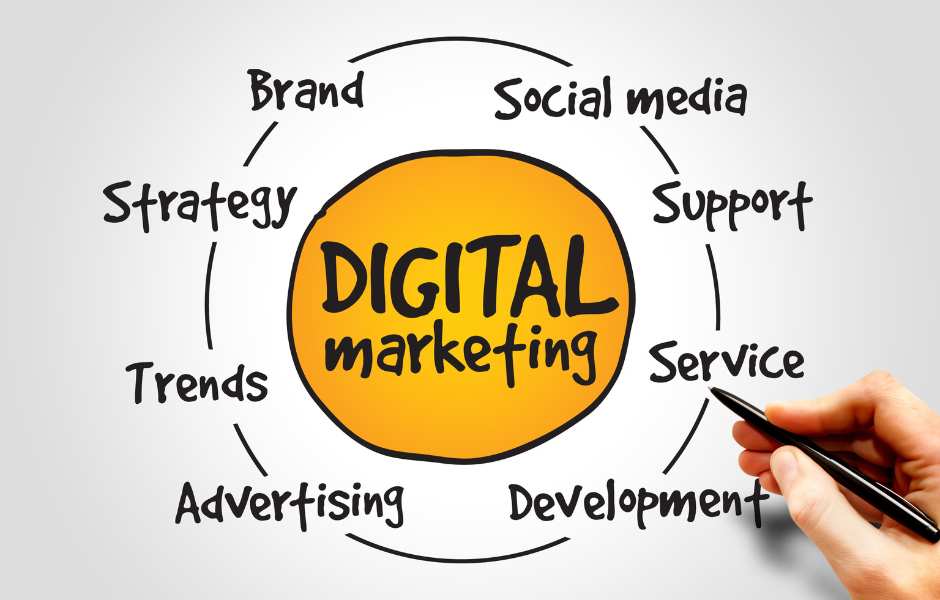Learn how to develop a successful digital marketing strategy that raises brand awareness, sparks interest, and creates measurable results.
A digital marketing strategy is crucial for any business to thrive in today’s hyper-connected digital landscape. However, creating a successful digital marketing strategy from scratch is a challenging task for any business.
Let’s start a journey towards establishing a powerful online presence and catapulting your business to new heights by defining your objectives, choosing the appropriate channels, optimizing content, and measuring success.
Building a successful digital marketing strategy from scratch involves several key steps:
Contents
#1. Define your goals
Define your digital marketing goals. Do you want to increase brand awareness, leads, website traffic, sales, or other metrics?
Your digital marketing strategy will take shape and be directed by these objectives. So, gain an understanding of your company’s overall goals and then tailor your digital marketing strategy accordingly.
What are your company’s long-term goals? Is it to reach a wider audience, promote brand awareness, increase leads, or increase sales and revenue?
Setting attainable digital marketing goals that contribute to the success of your business as a whole requires first establishing the big picture.
Make your goals concrete and quantifiable; otherwise, it will be hard to gauge your success. Instead, work on drafting aims that can be quantified and tracked.
Targets should be specific enough to be measurable; for instance, instead of “increase website traffic,” aim for “increase organic website traffic by 20% over the next six months.”
Having a defined endpoint like this makes tracking progress much easier. Make your objectives SMART (specific, measurable, attainable, relevant, and time-bound).
All targets must be specified, measurable, achievable, pertinent to the overall goals of the company, and time-bound.
Put your goals in order of importance and feasibility for your digital marketing campaign. Prioritise tasks that will have the greatest positive effect on your company’s growth.
Rather than trying to do too much all at once, it is more effective to focus on a manageable number of high-priority tasks.
Don’t forget about your intended readers when setting objectives and think about who you’re writing for. To what end are you employing them?
Do you want people to participate more, buy more, or be happier? Gaining insight into your target market’s wants and needs is essential to setting objectives that will help them.
Always evaluate your progress and make changes as necessary; the ever-shifting nature of the digital marketing landscape necessitates flexible objectives. Check on your progress and make necessary adjustments.
Keep an open mind and be willing to adjust your plans as market conditions, customer tastes, and company goals dictate. These steps will help you define crystal-clear, quantifiable, and strategically significant objectives.
#2. Identify your target audience
Finding your target audience is the first step in developing a successful digital marketing strategy. If you know who you’re talking to, you can create content that’s more likely to resonate with them.
Assess the makeup of your current clientele. Create buyer personas to understand your audience’s demographics, behaviors, pain points, and motivations. You can better meet the needs of your intended consumers if you are familiar with their demographics.
Get some background on their demographics, interests, goals, obstacles, and purchasing habits. Consider factors like age, gender, location, income, and occupation to identify groups with shared characteristics.
Conduct in-depth research on your industry, your competitors, and your potential customers. Gather information about consumers ‘, preferences, and problems through surveys, interviews, focus groups, and online research.
Find out who is already interested in your products or services by looking for commonalities among your customers.
Once you’ve gathered information from your existing customers and your market research, you can begin to develop buyer personas. These are just fictitious, broad types of people who represent your perfect clients.
Zero in on your ideal clientele and create in-depth personas, so you can learn more about your target audience and adjust your marketing strategies and tactics to illuminate potential avenues for expansion within your target market.
Learn about your website visitors and social media followers by using analytics tools. Customer relationship management (CRM) software, social media analytics tools, and analytics programs like Google Analytics and Facebook Insights all gather and analyze massive amounts of data about website visitors’ demographics, interests, and online behaviors. Examine this information to find commonalities and tendencies among your online readers.
Use social listening tools to monitor conversations about your industry or products on social media, online forums, and review sites. Pay attention to user concerns, inquiries, and comments.
The marketing strategy you develop can be informed by the opinions and desires of your target audience, which can be gleaned through careful social listening.
Constantly refine and test your assumptions as you gain more knowledge about your target audience. Based on the information you gather, modify your buyer personas, narrow your focus, or branch out to new types of customers.
Learn more about what resonates with your target audience by testing different marketing approaches and messages. Learning who you want to read your content is an ongoing task.
Revisit and revise the definition of your target audience from time to time as market conditions, consumer tastes, and your company’s offerings all change.
#3. Research your competitors
Doing competitor research is essential for informing your digital marketing strategy and gaining an edge in the market. To know who your major rivals are make a list of your top competitors.
Identify businesses that offer comparable products or services, target similar demographics of customers, or operate in a similar geographic area as your own.
Gather information about your competitors through online research, directory exploration, and word-of-mouth. Check out what your rivals have online by going to their sites and looking around. Analyze how well they work from a technical, usability, content, and messaging perspective.
Pay attention to their claims of value, USPs, and invitations to take action. Take note of the search terms they emphasize and the resources they make available, such as articles, videos, and downloadable guides. Follow their online channels like social media and email newsletters to learn more about them.
Find out what they sell and how it stacks up against what you offer. Learn about their unique selling points, like additional features, pricing, packaging, or promotions.
Check out how well they are received by customers and how highly rated their products or services are. Find places where you can fill a void or add value that no one else is offering.
Learn who your rivals are trying to reach by analyzing who they already are. Note the demographics of their customers and how they act.
Think like your target audience and examine their brand’s messaging, tone, and visuals to see how they stack up. Take advantage of social media and customer reviews to learn more about the wants and needs of your target audience.
Keep an eye on what they’re doing in terms of digital marketing and keep track of the rival businesses you’re up against.
Analyze how they’re doing in search engine results, social media engagement, email marketing, and paid advertising. Examine the methods they use to entice and retain their core customer base.
You can use tools like SEMrush’s EyeOn app to deliver key strategy insights about your competitor’s online advertising strategies. You can see their ads, promos, and pricing changes and get all the competitor intel you need to build a competitive brand in your market.
Keep up with the latest happenings in your industry and any gatherings in which your competitors may be present. To better understand the competitive landscape, participate in relevant industry events, read relevant industry publications, and follow relevant industry thought leaders.
Consider how your business fares in the market by conducting a SWOT (Strengths, Weaknesses, Opportunities, Threats) analysis of the collected data. Investigate the strengths, weaknesses, and potential areas of opportunity of your competitors.
Keep one step ahead of the competition by learning from their advertising moves, consumer tastes, and market tendencies. Having this data at your disposal will allow you to fine-tune your marketing strategy, differentiate your company from the competition, and increase sales and profits.
With this information in hand, you can hone your digital marketing strategy, find ways to set yourself apart from the competition, and boost your business’s performance. Keep in mind that you shouldn’t simply imitate your rivals, but rather use what you learn from them to set yourself apart.
#4. Choose your channels
Choosing the best marketing channels for your business requires careful consideration of your goals and the demographics of your target market.
These may include content marketing, social media marketing, search engine optimization, pay-per-click advertising, and email marketing.
First, identify your ideal customers by narrowing in on who you want to reach. Think about things like your target audience’s age, gender, interests, and habits. Using this data, you can pick the best channels to watch.
Establish what it is you hope to accomplish with your marketing campaigns. Your goals, such as spreading the word about your business, getting more people to visit your website, getting in touch with you, or making a purchase, will determine which channels you prioritize.
If you want more people to learn about your company, visit your website, get in touch with you, or make a purchase, you’ll need to prioritize different channels to achieve these objectives. Research the various distribution methods available to you.
Examples of well-liked channels of dissemination include social media (including Facebook, Instagram, and LinkedIn), search engine marketing (including Google Ads), email marketing, content marketing, influencer marketing, and even more conventional channels like print and broadcast media.
Next, determine which channels will work best for reaching your target audience and achieving your marketing objectives. Consider how many people you can reach, how interactive they can be, how much they will cost, who you can target, and how successful they will be.
Determine the best digital marketing strategies for reaching your desired demographic and achieving your goals. Think about the time, money, and people you have available. Allocate resources (both monetary and human) to the management of certain channels.
Select the channels that align with your objectives and budget to maximize your advertising spend. Before committing to an all-encompassing marketing strategy, test out a select number of channels.
Establish tracking and measuring systems to keep tabs on how each channel is performing. Examine metrics like user participation, sales, acquisition costs, and ROI.
Find out which platforms are best for expanding your business. Change and iterate by always checking how well your selected channels are doing. Look for room for development and make changes as needed. Keep an open mind and make adjustments to your marketing plan as necessary for best results.
Keep in mind that there’s no cookie-cutter method for selecting advertising mediums. Your business’s ideal distribution channels will change based on your target demographic, marketing objectives, and budget.
Regularly assess and adjust your digital marketing strategy to maintain currency and success in reaching your intended audience.
#5. Create your content
Create a content marketing strategy that serves your objectives and speaks to your intended audience. Content such as blog posts, videos, infographics, and social media updates are all fair game.
Establish your content marketing objectives first. For what purpose do you intend your writing? Possible goals include expanding the customer base, attracting new business, retaining current clients, and becoming a recognized expert in the field. The content creation process will be directed by your objectives.
Next, zero in on who you’re writing for by learning about their backgrounds, hobbies, interests, problems, and preferences. Use your buyer personas to stand in for distinct groups of customers. Knowing this will help you tailor your content to their interests and requirements.
Create a content calendar to help you plan and coordinate your content development activities. Plan out your publishing schedule and how you’ll promote your articles. Having a calendar makes it much simpler to maintain order and punctuality.
Find out what your audience is searching for by doing some preliminary research on keywords and topics. Discover high-volume search terms and evaluate how much competition there is for them with the help of specialized software like Google’s Keyword Planner or SEMrush.
Pay close attention to these keywords as you develop content for your audience. In SEMrush Academy’s free Content Marketing Fundamentals Course with Ashley Segura, you’ll learn everything you need to know to be a successful content marketer.
You’ll learn how to create content, what kind of content to create, how to measure whether it was successful or not, and what to do with it afterward.
Use search engine optimization (SEO) techniques to make your content more visible in online searches. Use relevant keywords throughout your content, including headings, subtitles, and alt attributes. Readability, page load times, and mobile device compatibility should all be prioritized.
Develop content that is useful, informative, and interesting to your intended audience and create high-quality content. Reach out to your audience through a wide range of content types, such as articles, videos, infographics, podcasts, and eBooks.
Every piece you put out should be thoroughly checked for accuracy before being published. Make sure people know about your content by using a well-thought-out distribution strategy.
It’s important to promote your content in as many places as possible, whether that’s through free methods like word-of-mouth or paid methods like social media ads or search engine marketing.
Track your content’s success with an analytics service like Google Analytics. Keep an eye on things like social media metrics, website engagement levels, and conversion rates.
Learn from the numbers what kinds of content resonate with your target demographic so you can fine-tune your approach.
Conduct a content audit to determine what is working and what needs to be changed. Find out where your content library is lacking and what pieces need updating or reusing.
You can learn where your content excels and where it falls short with this audit. Tweak your content marketing strategy based on new information and insights.
Figure out what’s working, and do more of it. To see steady progress, you need to try new things and maintain consistency, relevance, and value.
#6. Promote your content
Spreading your content via social media, email marketing, and other methods can help you reach a wider audience. Posts that emphasize the value of the content and have visual appeal are more likely to be read, watched, and shared.
Draw people in with catchy headlines, captivating visuals, and trending hashtags. Take advantage of multiple channels and maintain a presence on the social media sites where your intended audience spends the most time.
All the social media platforms like Twitter, LinkedIn, YouTube, and Pinterest are good choices. Respond to feedback, answer questions, and join pertinent discussions to build rapport with your target demographic and get more engagement and shares.
Invest in social media ads and use advanced targeting options to put your content in front of the right people. Encourage website visitors, blog readers, and social media followers to join your mailing list by asking for their email addresses.
Provide incentives for signups, such as access to premium content, discounts, or free resources.
Segment your email list’s subscribers to boost the usefulness and participation of your content and advertising campaigns. Send newsletters that will keep people interested and informed by using excerpts from your content.
Use enticing summaries to draw readers back to your site or blog, and include clickable links to the full articles. Use personalization strategies to address your email list members by name and adjust the message to reflect their specific interests and actions.
This can boost engagement and sales. Make it simple for your email readers to spread the word about your content by including social sharing buttons.
Look for opportunities to contribute guest blog posts to established websites or publications in your field. Add inbound links to your content from the guest posts to increase clicks and exposure.
Collaborate with influential people or experts in your field who already have built up an interested and responsive following. More people will see your content if others share it on their own websites, podcasts, and social media.
Syndicate your content on reputable platforms that specialize in content curation and distribution to increase reach and entice new viewers or readers.
Participate in industry-specific online discussion groups and forums. Insightful responses that answer user questions and provide pertinent links to related content are always appreciated.
#7. Measure & analyze your results
Measuring the success of your digital marketing campaigns requires effective analytics tools. Set clear goals and metrics that support your overarching marketing aims.
Do you want an increase in site traffic, sales, or brand engagement? Define the metrics that will serve as benchmarks as you work towards these objectives. Determine which analytics tools are appropriate for your needs depending on the channels and platforms you employ.
Analytics features of many social media and marketing automation platforms, such as Facebook Insights, Twitter Analytics, and LinkedIn Analytics, are also widely used in addition to web analytics tools like Google Analytics.
Have tracking codes properly implemented across all digital properties to guarantee precise measurement and data collection.
Including the Google Analytics tracking code on each page is a common practice for websites. It is important to properly configure the tracking features offered by most social media and email marketing platforms.
Identify the key performance indicators (KPIs) that will measure the success of your digital marketing campaign. These key performance indicators must be in line with your objectives.
Total visitors, unique visitors, bounce rate, average session duration, and conversion rate are all examples of key performance indicators that can be tracked on a website. Key performance indicators (KPIs) for social media include things like audience size, shares, comments, and clicks.
Perform consistent data monitoring and analysis by reviewing information gathered by your analytics tools. Measure what works and what doesn’t in terms of campaigns and content.
Examine information from a wide range of time intervals and compare the results. Seek out information that will shed light on user habits, preferences, and potential tweaks.
Make individualized reports by tailoring your analytics to include the data that matters most to your company. Make the data more understandable by displaying it visually. Communicate the success of your digital marketing efforts to your team and stakeholders through these reports.
Act on what you’ve learned and refine your approach to digital marketing with the help of analytics. Locate problem areas and devise solutions to boost performance.
Assess the results of your experiments on your key performance indicators (KPIs). Maintain a steady cycle of testing, learning, and improvement in your marketing strategy.
Keep up with the latest developments and trends in analytics by attending industry conferences and webinars, and reading relevant blogs or publications. Keep in mind that analytics is a never-ending cycle.
Better results can be achieved through digital marketing by regularly monitoring and analyzing data, making decisions based on insights, and continuously optimizing strategies.
By following these steps and constantly refining your strategy, you can craft a successful digital marketing strategy that helps you reach your business goals.
© 2023 – 2024, Priya Florence Shah. All rights reserved.
Priya Florence Shah is a bestselling author and an award-winning blogger. Check out her book on emotional self-care for women. Priya writes short stories and poetry and chills with her two-legged and four-legged kids in her spare time.
Discover more from Business & Branding Tips
Subscribe to get the latest posts sent to your email.
















